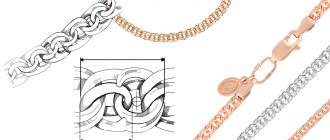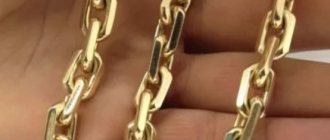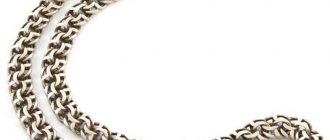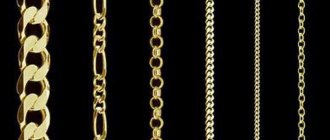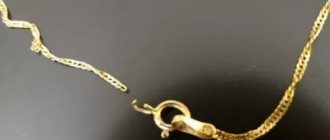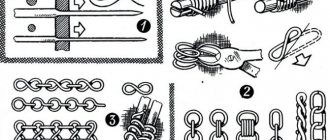Can a chain itself serve as an exquisite piece of jewelry? A hundred times yes, especially if it is made using some interesting technique. Today our focus is on Byzantium, or more precisely, on chains made using the same technique.
As a result of the filigree work of masters, self-sufficient jewelry is obtained, distinguished by incredible aesthetics, a kind of lace frozen in metal. Any pendant on them will look excessive.
Weaving a chain of gold Fox tail (a variety of Byzantium) is very difficult to perform - only experienced jewelers undertake it. Yes, such masterpieces are not cheap, but the exclusive cannot be cheap. And in this case we are talking about exactly that – the standard of high taste and an indicator of the corresponding status!
If you are choosing a chain as a “backdrop” for a pendant, it is wise to choose some kind of laconic weaving - anchor, chain mail, geometric Venetian.
Characteristic features of Fox tail weaving
Byzantine weaving is a very complex technique. It has characteristic features of both anchor and shell weaving, but, in essence, is an independent technique. Weaving is done link by link, but several links are located nearby, and in several planes.
Byzantium (Fox Tail, Byzantina, Roman Chain, Royal Bismarck) is woven exclusively by hand - such “smart” machines have not yet been invented. The jeweler arms himself with special thin-nose pliers, calls on all his experience and patience to help, and creates magic!
The result is luxurious, voluminous chains of very dense weaving. Moreover, the location and shape of the links can be very diverse - this is how fantasy weaving and exclusive jewelry are born.
Byzantine chains are very luxurious and solid. They are chosen mainly for men, as well as ladies of an elegant age - for young girls Byzantium is somewhat heavy. But there are exceptions: with an evening dress (for example, the notorious Chanel “little black”) such a chain will look great on any representative of the fair sex.
As mentioned above, weaving the Fox Tail chain is one of the many varieties of Byzantine weaving. Its characteristic feature is the direction of the links in one direction: they diverge at an angle, forming something like a fox tail.
The fox tail is less cumbersome and pretentious than the classical Byzantium. It is less demanding on bows: chains made using this technique can be combined with everyday women's and men's wardrobe, and, if desired, decorated with pendants carefully selected to match the style.
Byzantine weaving: basic basis and variations
Good day! Today we want to tell you about one of the most beautiful basic chainmail weaves known as Byzantine (aka Byzantine, Etruscan, Birdcage, Fool's Dilemma, Idiot's Trap, Idiot's Delight, Bird's Nest)
For work we will need the following: - thin-nosed pliers (platypus) for working with jewelry
It is fundamentally important to use thin-nose pliers without notches, otherwise the rings will deteriorate (scratch) during operation. In the photo above there are two options for thin-nose pliers: curved and straight. You can use any option. We personally use a pair of curved ones in the lead hand and straight ones in the trailing hand;
- a set of ready-made rings
in this case we take rings with an outer diameter of 5.5 mm and a wire thickness of 1 mm; - one hour time
So let's get started:
STEP 1.
We take an open ring and attach four closed rings to it.
Step 2.
We close the ring and add another one, also threading it through the four closed ones.
as a result of the first two steps we get a piece of the “2 in 2” chain
STEP 3.
Now we turn the outer rings in the opposite direction and hook the ring to them between the two middle rings.
Add another ring and get half a link in the Byzantine chain.
STEP 4.
We hook two more rings to the outer rings,
STEP 5.
and two more for them.
Then you need to repeat the third step (unfold the outer rings and place two rings between the previous ones)
As a result, we obtain a complete link in the Byzantine chain.
Next, we weave the chain following steps 4, 5, 3 to the desired length. You can use a carabiner or toggle as a clasp, your choice.
As you work, pay attention to how you close the rings - a ring that is not tightly closed can get scratched, cling to clothing and bend the weave. Try to close them “joint to joint.” Before attaching the clasp, make sure that the outer rings of the chain lie in the same plane (as in the picture after step 5); if the outer rings are rotated (as in the picture after step 3), then you should add another half of the chain link. Now you can attach the lock. Here is an example of a finished Byzantine bracelet with a carabiner
This weaving can be used both as an independent ready-made bracelet, and as a base on which you can attach beads, pendants, and anything else your creative nature desires.
But the interesting things don’t end there! You can use different sizes of rings.
On this bracelet we used rings with a diameter of 8mm and a thickness of 1.2mm. In step 1, you should hook 5 closed rings (instead of the original 4) and in step 3, thread 3 rings (instead of the original two). The result is a severe, voluminous bracelet with a very flexible weave. The same weaving is also suitable for rigid volumetric weavings.
In fact, we cannot even imagine when we will run out of options for this weaving, and we invite you to create with us, conduct creative experiments and come up with something new, interesting and beautiful!
Photos of the technical process taken from Cristian Badea's masterclass "Byzantine Chainmaille Tutorial"
Features of the Byzantine weaving chain
If we talk about the features of a chain made with Byzantine or royal weaving, then this is, first of all, solidity and representativeness. Despite the fact that the chain looks quite massive and voluminous, it does not seem visually heavy or too pretentious. At the same time, do not forget that the “Byzantine weaving” chain is durable, strong and beautiful. Due to the fact that complex weaving is used, the chain shimmers beautifully and originally in the light. The strength of the “fox tail” chain deserves special attention - in order to break it, you need to make a very serious effort, so you can wear it without taking it off and without fear of losing it.
We will create a chain from the customer’s material
We will be happy to produce a “Moscow bit” weaving chain from the customer’s material. Bring your gold to create a chain - if it is outdated, broken or simply no longer needed. Thanks to this, the cost of the finished decoration will significantly decrease, because you will pay exclusively for the jewelry work of weaving the chain. Each price presented in the section is current and final - we do not have a single hidden or additional payment.
If we use gold to make a chain, 10% of the gold always goes to technological losses: cleaning the metal to pure gold, as well as subsequent operations to assemble the chain, polishing it and grinding it. Therefore, if the chain weighs 50 g, 55 g of metal will be needed to make the chain.
We will be happy to add a gold workshop to make a chain from your gold if required. Technological losses do not apply to workshop gold.
How to weave a chain “Byzantine weaving”
Any jeweler will confirm that the technology of Byzantine or royal weaving is considered one of the most complex. A chain is made by connecting individual elements of the same size in series. Moreover, the links are distinguished by a variety of shapes; they can be in the form of a square, oval or circle. The production process itself is complex, painstaking and takes a lot of time from the jeweler, as it requires care and many years of experience, otherwise you can break the integrity of the chain and produce links of different sizes with different angles of inclination relative to each other.
Production time. Delivery
The production time for the Moscow Bit weaving chain is from 10 days. If you want the chain to be made by a certain date, please specify and we will take this into account when drawing up the work schedule.
Delivery of our products is free of charge throughout Moscow and any region of Russia. In Moscow, delivery is carried out by courier on any day, at a time and place convenient for you. Delivery throughout Russia is carried out by an operational logistics team with personal delivery and full insurance of valuable shipments. Delivery times in Russia are very fast: from 2 to 4 days.
Order the “Moscow bit” chain from a trusted workshop
A custom-made gold chain is a timeless piece of jewelry that is perfect not only to wear as a decoration, but also as an independent, separate piece of jewelry.
By ordering a “Moscow bit” chain from the jewelry workshop of Grigory Melikov, you are purchasing a guaranteed product of high quality and excellent performance with the appropriate quality certificates. To create “Moscow bit” chains, we use only pure gold bars of the highest standard. The gold quality standard is checked by the Moscow Assay Supervision Inspectorate, which, after a thorough check, leaves its mark on the jewelry.
Each chain is carefully assembled, and after tumbling it is subjected to careful grinding and several types of polishing. That's why we give you a chain that has a flawless shine that lasts for months of wear. We confirm the quality of our chains with a numbered studio quality certificate and guarantee long-term after-sales service.
Our chains are very strong, beautiful and durable. Our own production of chains allows us to monitor every stage of its creation very carefully, so our products meet their customers when they are completely ready and impeccable.
What and who should wear a Byzantine weave chain with?
The “Byzantine weave” chain is clearly not an option for young people, since it is more suitable for older and accomplished people. In most cases, men over 30 years of age prefer to buy such a chain in our workshop, since it is on them that it looks most logical. An important feature of products made using this weaving technique is that they can be worn either independently or with additional decorations in the form of amulets, amulets and pendants. The “Byzantine weaving” chain looks solid, laconic and self-sufficient. When decorating a chain with additional elements (pendants or amulets), it is worth remembering that the weight of the pendant should not be greater than the weight of the chain.
Peculiarities
Jewelry made using Byzantine weaving looks voluminous and interesting. In gold, such chains perfectly complement a formal look, and in silver - classic, office. They are best suited for middle-aged ladies who dress discreetly and tastefully.
The royal weaving method should be considered on popular jewelry made using this technology. As an example: the Byzantium chain, which can often be found on the shelves of jewelry stores. This jewelry is impressively thick, so it is not suitable for everyday wear. But at the same time, the Byzantine chain will be an excellent addition to a festive outfit.
It is produced in several versions, including:
- silver;
- gold;
- platinum.
Chains made using the fox tail technique do not require decorated elements. These jewelry look laconic, they are created in order to emphasize the status of a person. Byzantine weaving looks beautiful on products of any length. It can be used to make bracelets, chains and even small keychains.
This technology is painstaking and complex. In jewelry stores, products made using the Byzantine weaving method are much more expensive than similar ones. The fox tail technique is used to produce massive jewelry. If we compare this weaving with less voluminous ones, for example, anchor or diamond, we can note that Byzantine, against their background, looks much more interesting.
Royal weaving is carried out by connecting identical elements in series.
The links can be square, oval or round. Often, jewelers combine silver and gold fragments into one piece to create an original and intricate piece of jewelry.
Weaving a chain using this technology usually takes a lot of time, especially if the master implements some interesting pattern. Jewelers use the following tools in their work:
Thin nose pliers without serrations. The use of this particular tool to connect the links is important, since the elements should not be damaged.- Fragments of suitable shape and size. It all depends on what kind of product should be obtained in the end. The thickness of the chain directly depends on the size of the elements used.
The royal technology is one of the most complex; not every novice jeweler can replicate it at home. In addition, decoration made by yourself will be less durable and neat.



